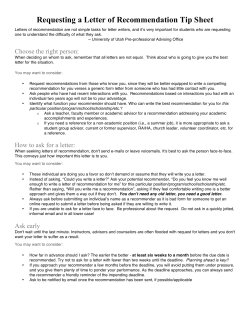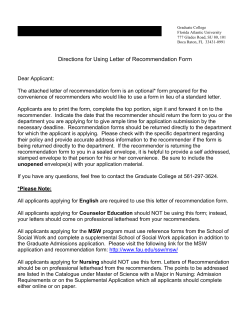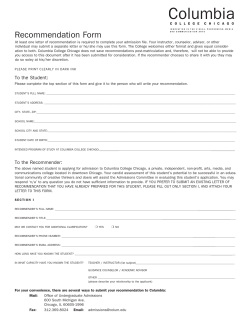
Analysis and Design of Hybrid Online Movie Recommender
Analysis and Design of Hybrid Online Movie Recommender System Harpreet Kaur Virk Department Of Computer Science Chandigarh University Gharuan, India Er.Maninder Singh Department Of Computer Science Chandigarh University Gharuan, India Er. Amritpal Singh Thapar University Patiala, India Abstract--- Online Recommender Systems generally referred to those used for suggesting items out of many choices in ecommerce websites. Various approaches have been adopted and validated on large scale, not much research is done to incorporate contextual information of the user in the recommendation process. Re-ranking of recommended material is difficult, if the system does not have any information about the context of the user which has direct impact on the pertinence of the recommended items. The proposed approach is the incorporation of contextual information which furnishes enhanced and improved recommendations. The system has been validated using standard dataset of movie available online. I. INTRODUCTION In this age of information overload, users have various strategies to make choices, so it becomes difficult for them to choose the best from variety of options [1]. This contributes to the emergence of new technology- recommender system [2]. Recommender Systems are software tool or technique which provide or suggests items for users. These are being applied in various fields such as movie recommendations, songs recommendations, e-commerce [3] and many more. A recommender system works by procuring the knowledge of users either explicitly or implicitly [4] and of items and has the following classification [5]. Recommender System Collaborative Based Uses similarity between users and items Content Based Uses similarity patterns of items or Demographic Based Uses demog raphic profile of user Fig.1. Classification of Recommender System Knowledge Based Uses specific domain knowledge of user Hybrid Combines two or more techniques Three approaches commonly used are collaborative filtering, content-based filtering and hybrid filtering which is combination of two or more approaches. However, the majority of these and other approaches have focused using on ratings information for recommendation, while ratings are important. What is missing from the most of the recommendation approaches is context. The context of recommendation process can comprise a wide range of information, such as time, location and device used, etc. User context can be equally important to the recommendation process, such as mood or social networking information. Relationships between users for instance are beneficial for recommendation performance [6, 7]. The third type of contextual information for movies include context about themselves, such as actor, director and more. This paper presents a movie recommender system, based on content and collaborative filtering including contextual information. In content-based recommender system recommendations are provided with profiles of users which are created at the beginning. A profile has information, such as age, gender, taste, etc. Taste is based on how the items are rated by the user. To recommend, the engine compares the items that were rated by the user with the items that are not rated by the user to calculate similarities. Those items that are similar to rated items will be recommended to the user. The proposed system using the collaborative filtering, this focuses on relationship between users and items. Similarity of items is determined by similarity of ratings of those items by the users who have rated both items. Consequently, many users are required to make ratings on many items for better recommendations. Though, users are frequently unable to assess all the items in the system, which lead to the ‘rating sparsity’ problem in collaborative filtering systems [8]. Another issues which have been pointed out as restrictions to the system are scalability and transparency [9]. Moreover, the system also exhibit vulnerability on security. This paper uses contextual information to cope with sparsity and scalability issues inherent in collaborative filtering approach use in movie recommendation systems. This paper consists of five sections. Section II describes related work. Section III describes the methodology to be followed to recommend movies to the user. Section IV is discussion and future work. Section V wraps up this paper with its conclusion. II.RELATED WORK Many of the recommender systems have been developed and are in use in variety of domains. These systems use variety of approaches [5]. Number of the online recommendation systems for a variety of applications recommends items to active users based on ratings provided by previous users with similar interests. One such system was designed by Jung, Harris, Webster and Herlocker in 2004 to improve search results. The system motivates users to enter extended and more informative search queries, and collects ratings from users concerning whether the search results meet their information need or not. This rating information is then used to make recommendations to later users with similar needs. Filtering techniques have been applied in many contexts, and the proposed system is not the first to attempt to make predictive recommendations about movies. MovieLens and many more are examples that implements recommender systems in context of movies. MovieLens is an online recommender system in which the user is asked to rate certain movies at first login to the system. This information is then used to recommend movies to the user which has not seen yet. It uses collaborative filtering as well based on ratings by similar. The GroupLens Research Group has also designed a version of MovieLens such as PDA but that is not always connected to the internet. Contextual information is another facet that can be used for improved recommendations. This is extremely helpful in recommender systems where other factors such as the time, location, etc. also play an important role in user preferences. The systems utilize such information in providing recommendations are known as context-aware recommender systems. In the present era, when the mobile devices are getting popular in our day to day life, these sorts of recommender systems are especially important. Using GPS and other technologies recommender systems can quickly get any information about location of the user and user itself. [10] Gediminas Adomavicius and Alexander Tuzhilin introduced three different algorithmic paradigms to incorporate contextual information in recommendation process: contextual pre-filtering, post-filtering and modeling. In contextual pre-filtering, contextual information is used before predictions of ratings using any approach. In contextual, post-filtering contextual information is used for filtering after predictions of ratings. In the modeling paradigm, contextual information is used in recommendation approach itself. [11] From the literature survey we conclude that sometimes the recommendations are not relevant in our daily life. Only pre-analysis is performed for recommendations and also the data retrieval is not fast. In this paper, a hybrid recommender system is proposed which provide more relevant recommendations and also fast retrieval of data with pre and post analysis and using this system for movie recommendation after gathering user and item data. III.PROPOSED WORK This paper proposed a hybrid recommender system which provides movie recommendations based on content and collaborative filtering and also using context for better recommendations. The methodology to recommend movies has the following steps with explanation: a) Initially the relevant features have to be gathered used in movie recommendation. b) After collecting data also including rating data and contextual information, we apply advance algorithm for relevant recommendation. Step 1 Step 3 Step 2 New User sign in Recommenda tions Store user information Neighbor set Fetch ratings of movies Gather movie information Movie Database Movie recommender User database Fig.2. Flowchart for the proposed system Step 1: Collect user information For the new user, the system requests to register him an account to gather his personal information and also the ratings of a set of movies. Step 2: Create movie database Collect the movie information such as title, actors, director, release date, ratings etc. for recommendations. Step3: Movie Recommender This phase recommend movies to the user and use following steps for recommendation: User record Fetch movie information No Last record Yes Find movies of maximum rating Generate list of recommendations Fig.3. Flowchart for updating movie recommendations IV.DISCUSSION AND FUTURE WORK Finding the relevant information from huge amount of data available online is very difficult. Recommender systems are solution to this problem which provides relevant recommendation. The proposed system use hybrid filtering technique for movie recommendations and further we can add more datasets available online. Also we can use social tagging to enhance the system. V.CONCLUSION In everyday life users rely on recommendations from other people either by word of mouth, movies and book reviews in newspapers etc. This system help users by providing relevant movie recommendation based on user feedback using simple GUI. This system will help users to deal with information overload by giving them better recommendations. REFERENCES [1] [2] [3] F Ricci, L Rokach, B Shapira, “Introduction to recommender systems handbook,” Springer US, 2011. P. Resnick and Hal R. Varian, “Recommender Systems. Communications of the ACM,” 40(3):56-58, 1997. J. Ben Schafer, J. Konstan, and J. Ri edl, “Recommender Systems in E-Commerce,” pp. 158–166, 1999 In Proceedings. [4] [5] [6] [7] [8] [9] [10] [11] [12] [13] [14] K. Choi, D. Yoo, G. Kim, and Y. Suh, “A hybrid online-product recommendation system: Combining implicit rating-based collaborative filtering and sequential pattern analysis,” Electron. Commer. Res. Appl., vol. 11, no. 4, pp. 309–317, Jul. 2012. R. Burke, “Hybrid Web Recommender Systems,” Springer Berlin Heidelberg, pp. 377–408, 2007. G. Groh and C. Ehmig, “Recommendations in Taste related Domains: Collaborative Filtering vs. Social Filtering,” In Proceedings of GROUP ’07, pp. 127–136, 2007. ACM. A. Said, E. W. De Luca, and S. Albayrak, “How Social Relationships Affect User Similarities,” In Proceedings of the 2010 Workshop on Social Recommender Systems, pp. 1–4, 2010. H. Lee, H. Kim, “Improving Collaborative Filtering with Rating Prediction Based on Taste Space,” Journal of Korean Institute of Information Scientists and Engineers, Vol.34, No.5, pp.389-395, 2007. P. Li, and S. Yamada, “A Movie Recommender System Based on Inductive Learning,” IEEE Conf. on Cybernetics and Intelligent System, pp.318-323, 2004. W. Woerndl and J. Schlichter, “Introducing Context into Recommender Systems,” Muenchen, Germany: Technische Universitaet Muenchen, pp. 138-140. G. Adomavicius and A. Tuzhilin, “Context-aware Recommender Systems,” in Recommender Systems Handbook: A Complete Guide for Research Scientists and Practitioners, Springer, 2010. T. Bogers, “Movie recommendation using random walks over the contextual graph,” in Proc. of the 2nd Workshop on Context-Aware Recommender Systems, 2010. Tang, T. Y., & McCalla, “A multi-dimensional paper recommender: Experiments and evaluations,” IEEE Internet Computing, 13(4), 34–41, 2009. Sarwar, B. M., Karypis, G., Konstan, J. A., & Riedl, “Item-based collaborative filtering recommendation algorithms,” In: Proceedings of the 10th international World Wide Web conference, pp. 285–295, 2001.
© Copyright 2025










